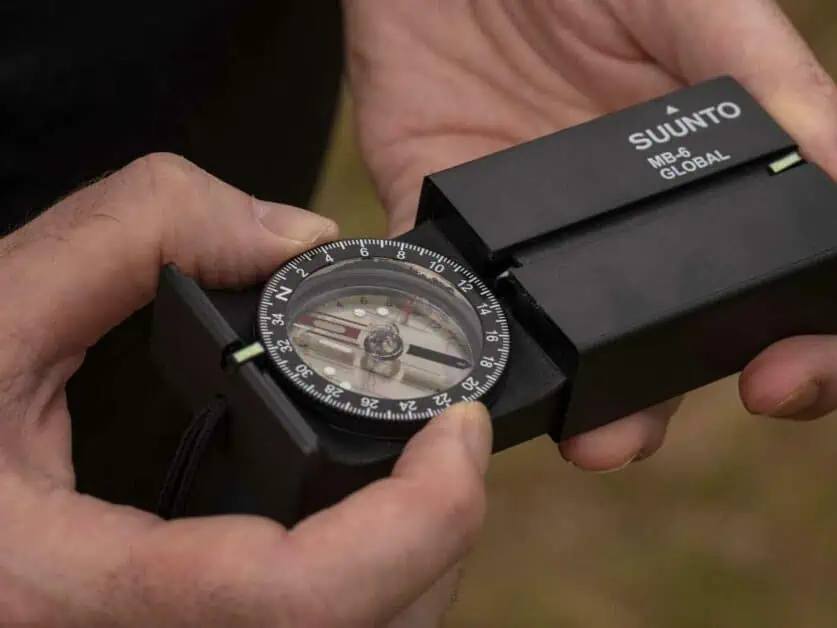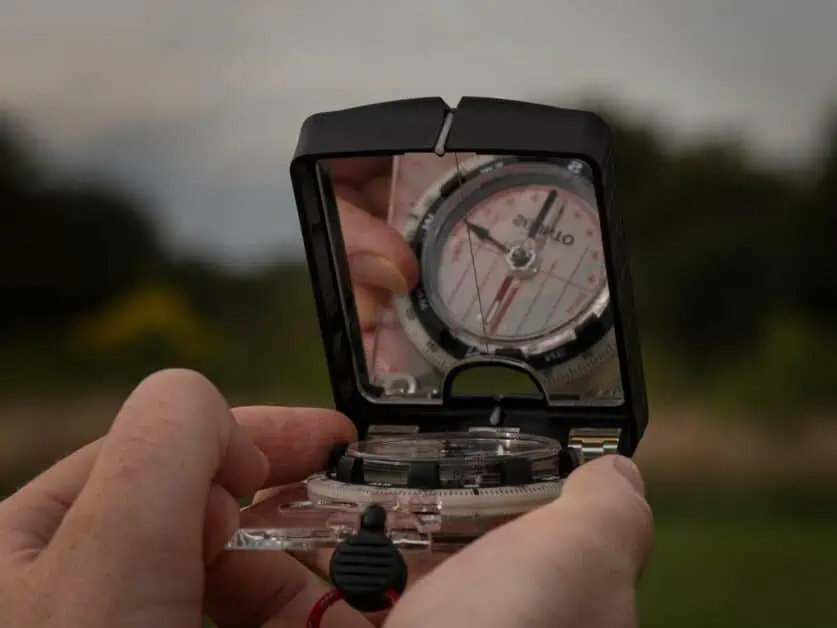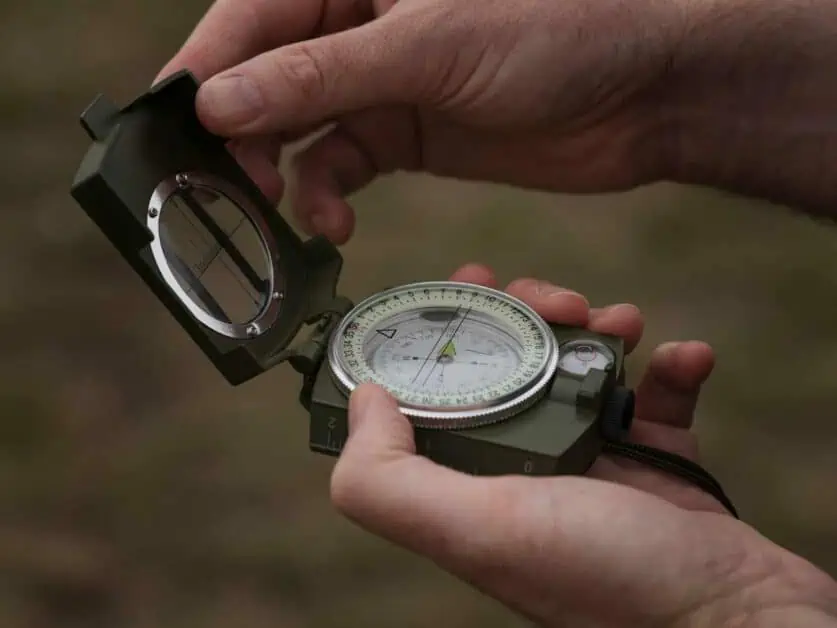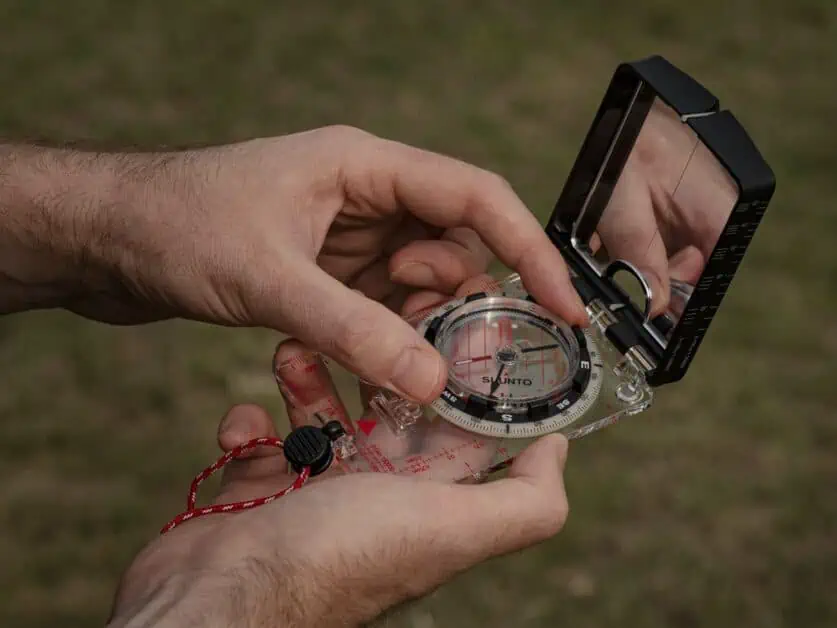
Table of Contents
ToggleWhere We Test
Real world testing is the backbone of everything we do! A piece of equipment might have a good specification, look good and feel well-made, but if it doesn’t perform on the trail, then is it really any good? Your equipment choices are very important. At one end of the scale, they can make a big difference to your enjoyment of a hike – a compass that’s easy and comfortable to use just lends itself to a better experience than something that’s fiddly or difficult to work with, especially in less than perfect conditions. However, a compass is also an important piece of safety – even survival – equipment, so knowing your choice performs well in real-world conditions is, in our opinion, an important factor.
Editor’s Note: This article is part of our overall guide to the best hiking compasses. Check out our other guides:
Testing Metrics
We’ve looked at several key areas in our testing for our hiking compass round-up: we’ve looked at build quality and durability, materials used, price, ease of use and any other tools and aids that are integrated into the product. In terms of features, we think that more isn’t always better when it comes to compasses: For example, many baseplate compasses feature scales printed on their transparent base intended to help with map reading. These might sound good when reading a spec sheet, but in reality, an abundance of different scales can lead to a visually cluttered product that’s confusing to work with. Ur testing metrics aim to drill past the raw specification to analyse how useful each aspect of the product really is.
Type of Compass
There are many different types or basic designs of compass. We’ve concentrated on the types that we think are most relevant to hikers.
Button
Button compasses are generally very small, light and basic devices. They provide the minimum of information in the smallest package. You can do a lot with a button compass and they are very useful for trail runners or those who prioritise speed. However, we prefer a more featured baseplate or mirror design.
Wrist
A wrist compass is basically a button compass worn like a watch. These can be very useful if you need to regularly reference your compass on tricky terrain or in a hurry.
Thumb
A thumb compass is a small compass with an integrated thumb loop – it’s intended to be worn for the duration of a hike or run rather than being put on when needed. We don’t think these are really suitable for general hiking, but for some applications, like trail running, they could work well.
Baseplate or Orienterring
A Baseplate compass is likely what most people think of when they visualise a compass and we think that along with mirror compasses (see below), they are the best choice for general hiking or trekking. A plastic base – that’s almost always transparent – surrounds the actual compass and is typically marked with various rulers and scales to help with map navigation. These compasses often also incorporate magnifying lenses for reading map details – and, of course, these can also be used to start fires, help identify splinters etc.

Mirror
Mirror compasses are basically Baseplate compasses with a folding mirror attachment. The mirror makes it easier to take bearings from the compass in reference to features in the landscape. Theya re a bit bulkier and have a bit of a learning curve, but, once you’re used to them, they are also quicker to use and arguably more accurate than a plain baseplate compass. The mirror can also be used for signalling to attract attention in an emergency. This is our design of choice.
Lensatic or Military Style
Whilst they look quite different, a Lensatic compass is similar to a mirror compass in terms of how it operates. A sighting system helps the user to take precise bearings from features in the landscape. This compass type has been adopted by armies around the world and those with military backgrounds often swear by them. In a nod to their military application, these compasses often have extra-rugged build. However, we still think a mirror compass – which typically have navigation scales printed on the base – is more useful for general hiking. If you buy a military spec or army surplus lensatic compass, bear in mind that they can come with their scales marked in ‘Mils’ (milliradians) rather than degrees and conversion between the two is not a straight-forward mental calculation for most people (1Deg = 17.453Mils).

Transit
Transits are often mentioned alongside compasses. A transit is a precision compass used in applications like quantity surveying, construction and scientific fieldwork where very accurate measurement need to be made. Relative to the other types of compasses mentioned here, they are much larger, heavier and typically way more expensive. You could certainly use a transit to navigate on a hike, but for general outdoor activities, we see no good reason why you’d want to do this.
Adjustability & Accuracy
Accuracy and adjustability are two key characteristics of any compass. Manufacturers typically quote accuracy in terms of a margin of error in degrees – so +/-2 means that you can expect a measurement from that compass to be within 2 degrees of the true measurement. As with all technology, it’s easy to get fixated on accuracy – and this makes perfect sense. However, for typical hiking – even long-distance hiking – applications, compasses do not need to be critically accurate and a compass with an accuracy of +/-5 degrees will still be absolutely fine for most recreational outdoors uses. Also bear in mind that metal equipment and magnets can interfere with compasses, so bear this in mind in use.
Adjustability typically refers to declination correction. Inconveniently, the Earth’s magnetic pole (‘Magnetic’ North) does not correspond to actual North Pole (‘True’ or ‘Geographic’ North) and indeed the North/South meridian (or grid!) lines on your map (‘Grid’ North) may not correspond to either. So, we are left with three slightly different Norths! To make thing more complicated, the Earth’s magnetic pole constantly moves around – today, it’s relatively close to the ‘True’ North, but in the early twentieth Century it was in Northern Canada. The needle in your compass points to Magnetic North, but we need to navigate relative to Grid North on our maps. If your compass allows for declination correction, we can use this to compensate for this variance (or, you can do it as a mental calculation).
This all sounds very complicated, but the correction is very easy to apply. Most hiking maps will either state the Declination angle or have a scale from which you can work it out. However, bear in mind the age of the map. As mentioned above, Magnetic North moves over time, so the older the map, the less reliable this data is – and anything over a decade out could be quite inaccurate. The NOAA – a US government agency – has an online tool that gives up to date Declination data (and you can even use to get historic data if that’s your thing!), or there’s a similar tool available at magnetic-declination.com which is a little more user-friendly. Here’s we can search for a major location near where we’ll be hiking, find the relevant declination angle and apply it to our compass.
The Earth’s magnetic field is variable and incredibly complex, so the declination angle varies based on where in the world you are and does not follow patterns of latitude or longitude. In the UK, for instance, it’s so small that no compensation is really necessary for most purposes and indeed, the correction required in most of Europe is typically very small. However, in the United States, the correction required can be quite significant and would even shift substantially over a very long distance hike like the PCT.

Compass Features
In many respects, a compass is a very basic tool – it really only has one task to perform. However, many compasses – especially baseplate compasses – come with added features. Typically, these are navigation aids that make route plotting and finding on maps much easier. These typically take the form of scale rulers matched to common map scales; rulers; magnifying lenses to help with small printed details and text on maps; Romer scales to help pinpoint positions in grid squares and every GPS confidence markings to help visualize GPS accuracy. To be clear, none of these features are essential, and indeed if there’s too many of them, operating the compass can become confusing. However, these features can add to the usability of a compass and can certainly be helpful both when planning routes or when navigating on the trail.
Many of the compasses we’ve assessed also feature luminous elements to help with use in low light. This mostly uses phosphorescent paint that needs to be ‘charged up’ with light, but we’ve also noted tritium-filled vials being used. Tritium naturally glows (this is a product of its radioactive decay – but don’t worry about this, as used in compasses, it’s completely harmless to humans), but will eventually ‘run out’ after around twelve years.
Certain features on compasses can have extra utility beyond navigation. The mirror on a mirror compass can be used to signal for help in an emergency, for instance and the magnifier found on many baseplate compasses could also be used to start a fire.
Size & Weight
Size and weight are important factor for any piece of outdoor gear and whilst none of the compasses we’ve assessed are particularly large or heavy when compared to much of the other equipment you might carry on the trail, weight and volume do add up, so it’s important to consider what contribution you compass makes to the overall weight of you kit bag. Realistically, we think that most people reading this round up will be carrying a compass as a backup to a GPS navigation unit. With this in mind, it might make sense to purchase a less heavily features, but also smaller and lighter compass.
Ease of Use
Compasses are not an item that many of us will have day-to-day experience of using and we’d even suggest that many people reading this round up may never have actually navigated with a compass. The most basic function of a compass – pointing North – is fairly self-explanatory, but taking accurate bearings, and translating those to a map – or visa versa – requires a deeper understanding of how map and compass navigation works. We don’t think this is particularly difficult, but it is a totally new skill for many people.
How easy a compass is to use really comes down to a lot of factors. Your familiarity with how they work is the key factor, but things like legibility of any scales, extra navigation aids as well as good old ergonomics all play a par there too. Many compasses feature very small lettering, so don’t forget to factor in your eyesight into any purchasing decisions too.
Durability
Durability is another key feature for any piece of outdoor gear. The great news is that every compass we’ve assessed here – and, in a wider sense, most other outdoors compasses we’ve seen – are all fairly sturdy pieces of kit. They are not indestructible, but you also don’t need to be ultra careful with them. Every compass in our round up has some degree of weather and extreme, temperature resistance meaning you won’t need to worry about them in the vast majority of circumstances. Most of the compasses we’ve assessed have the needle suspended in a liquid filled capsule and these can develop air bubbles that impact accuracy as a result of impacts or altitude changes. The manufacturers of many of the compasses we’ve assessed – including Suunto, Brunton and Silva – all offer aftersales care and will be happy to help with nay major problems.
Price
In the grander scheme of things, your compass is very unlikely to be the most expensive piece of outdoors equipment you own and whilst the prices of some of the units we’ve assessed may raise a few eyebrows, they are also not incredibly expensive either. As many people are likely to be buying a compass as a backup to a GPS unit, we think there’s an understandable temptation to buy cheap here. However, a compass is a potentially life-saving piece of equipment, especially if you hike in the deep wilderness, so we think it’s one area where it’s well worth sticking with a reputable brand.
Disclaimer: This article contains Affiliate Links. You won’t pay any more for buying through these links, but we may receive a commission from any purchases made through them. As an Amazon Associate, I earn from qualifying purchases. If you choose to support us by buying through our links, we thank you as it helps us to continue providing the resources we do to help you enjoy the outdoors more!
